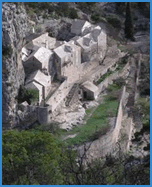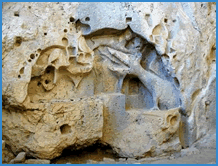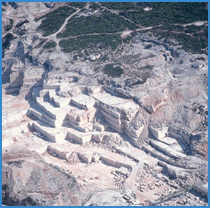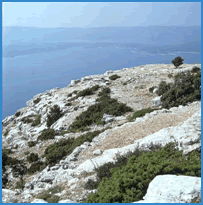BRAC - more information
HISTORY OF ISLAND BRAC
The island of Brac, whose protector is St. George, has a very rich history. The
evidence of life existence dates back even to the stone-ages (3000 B. C.).
In the 4th century B.C. the island was settled by the Illyrian tribe Delmata
after whom was Dalmatia named.
Greek colonization was not present like
on the other islands, but in the Roman time were formed
many Roman settlements (villa rustica), thanks to the exploitation
of the well known stone. From this white stone was built
the Diocletian’s palace in the town of Split.
In the 7th century came Croats and, after
their Christianization, life on the island became more
dynamic. Venice had big influence on the island because
it ruled almost 4 centuries. The danger of the Turks on
the mainland was the reason that Brac had more and more
immigrants. In the time of French ruling, thanks to the
numerous reforms, life on the island became better for
its habitants, and then in the time of Austrian Habsburg
monarchy in the 19th century important settlements on the
island was connected by roads. In that time Brac became
known for its quality wine which was exported around Europe.
In the beginning of the 20th century vineyards
were slowly destroyed by the disease and this was the reason
for a massive emigration to oversea countries, especially
to Chile. In the 1st and in the 2nd World War the life
on the island was very difficult. After liberation from
the fascism island Brac became part of the socialistic
Yugoslavia. From 1991. island Brac is part of the independent
Republic of Croatia.
HIGHLIGHTS
 DESERT
BLACA - Desert Blaca is situated on the west
side of the mountain Vidova gora. It can be reached only
by macadam road (around 6 km) and walking path (around
30 min. walk). Blaca has great cultural, scientific and
architectural importance, not only for the island Brac
then for the whole of Dalmatia. Desert Blaca is actually
an eremitical monastery which was founded by the Glagolitic
priests from the mainland who escaped the Turks around
year 1550. After the permission of the island authorities
to settle down on this area, throughout the centuries
this simple cave shelter of Ljubitovica became monastic
and economic complex of great importance. The priests
lived independently over 400 years till 1963 when the
last priest died and the monastery turned into a museum.
Monastery Blaca was built in an interesting position
hidden between high cliffs of the canyon and this gives
it a mysterious charm. Within the monastery there is
a church, then a school for children, a library with
nearly 8000 books on 5 languages, an astronomical observatory
etc. The monastery of Blaca will surely surprise you
with its beauty and history, so don’t miss to visit
this exceptional locality.
DESERT
BLACA - Desert Blaca is situated on the west
side of the mountain Vidova gora. It can be reached only
by macadam road (around 6 km) and walking path (around
30 min. walk). Blaca has great cultural, scientific and
architectural importance, not only for the island Brac
then for the whole of Dalmatia. Desert Blaca is actually
an eremitical monastery which was founded by the Glagolitic
priests from the mainland who escaped the Turks around
year 1550. After the permission of the island authorities
to settle down on this area, throughout the centuries
this simple cave shelter of Ljubitovica became monastic
and economic complex of great importance. The priests
lived independently over 400 years till 1963 when the
last priest died and the monastery turned into a museum.
Monastery Blaca was built in an interesting position
hidden between high cliffs of the canyon and this gives
it a mysterious charm. Within the monastery there is
a church, then a school for children, a library with
nearly 8000 books on 5 languages, an astronomical observatory
etc. The monastery of Blaca will surely surprise you
with its beauty and history, so don’t miss to visit
this exceptional locality.
 DRAGON’S
CAVE - Zmajeva špilja (Dragon’s cave)
is situated on the south side of the island, underneath
the cliffs of Vidova gora and over the village of Murvica.
It can be reached by the picturesque walking path (around
40 min. walk). The historians didn’t exactly establish
when or who made this rare monument, but its cultural
and artistic (and secret!) value is not in question.
Inside the cave there are many reliefs of figures from
the Slavic mythology and Christianity made in the very
stone of the cave. The dominant figure is one with the
dragon and the cave was named after it. The eremites
who lived here long time ago probably enjoyed beautiful
nature and the panoramic view as well as today’s
visitors who are coming to see this mysterious cave.
Nearby there are several abandoned monasteries which
are also worth to visit.
DRAGON’S
CAVE - Zmajeva špilja (Dragon’s cave)
is situated on the south side of the island, underneath
the cliffs of Vidova gora and over the village of Murvica.
It can be reached by the picturesque walking path (around
40 min. walk). The historians didn’t exactly establish
when or who made this rare monument, but its cultural
and artistic (and secret!) value is not in question.
Inside the cave there are many reliefs of figures from
the Slavic mythology and Christianity made in the very
stone of the cave. The dominant figure is one with the
dragon and the cave was named after it. The eremites
who lived here long time ago probably enjoyed beautiful
nature and the panoramic view as well as today’s
visitors who are coming to see this mysterious cave.
Nearby there are several abandoned monasteries which
are also worth to visit.
 REGIONAL
MUSEUM OF THE ISLAND – ŠKRIP Škrip
is the oldest settlement on the island of Brac. Set on
the top of the hill, with its belfry, church facade and
huge towers it appears like a town lost in this stony
area by coincidence. Škrip is a town-monument in
which Illyrians, Romans and Croatians deposited their
ethnic layers, as the evidence of their presence. It
is the whole of Brac in itself and it represents a very
heart of the authentic island. In Škrip, there is
the Regional Museum of the island with its rich collection
from Roman time, late antiquity and early medieval monuments
and sculptures as well as interesting ethnographic collection.
REGIONAL
MUSEUM OF THE ISLAND – ŠKRIP Škrip
is the oldest settlement on the island of Brac. Set on
the top of the hill, with its belfry, church facade and
huge towers it appears like a town lost in this stony
area by coincidence. Škrip is a town-monument in
which Illyrians, Romans and Croatians deposited their
ethnic layers, as the evidence of their presence. It
is the whole of Brac in itself and it represents a very
heart of the authentic island. In Škrip, there is
the Regional Museum of the island with its rich collection
from Roman time, late antiquity and early medieval monuments
and sculptures as well as interesting ethnographic collection.
 SCHOOL
FOR STONE-CUTTERS – PUCIŠCA On the
island Brac which is an everlasting source of white stone,
the tradition of stone-cutting dates back to the time
of Romans. From this famous stone were built some of
the world well-known buildings (the Diocletian’s
palace in Split, the White house in Washington, the Parliament
in Budapest, and the Reichstag in Berlin etc.) This old
tradition continues even today, especially in the town
of Pucišca where exists a unique school for stone-cutters
(the only one in this part of Europe). In this school
young people learn, like their ancestors, how to do this
difficult job.
SCHOOL
FOR STONE-CUTTERS – PUCIŠCA On the
island Brac which is an everlasting source of white stone,
the tradition of stone-cutting dates back to the time
of Romans. From this famous stone were built some of
the world well-known buildings (the Diocletian’s
palace in Split, the White house in Washington, the Parliament
in Budapest, and the Reichstag in Berlin etc.) This old
tradition continues even today, especially in the town
of Pucišca where exists a unique school for stone-cutters
(the only one in this part of Europe). In this school
young people learn, like their ancestors, how to do this
difficult job.
 VIDOVA
GORA “The continent of Brac” is
an exceptional island because of the Vidova gora mountain
which is the highest peak of all Adriatic islands (778
m). The very top of the mountain can be reached by a
car, and from the top spreads a breathless view on the
slope of the south side of the island, the town of Bol
and the famous beach Golden Cape (Zlatni rat) as well
as on the islands of Middle Dalmatia. At high visibility
even the Italian coast may be seen. Vidova gora hides
many wonders of nature: from the dense forest of authentic
black pine trees (Pinus niger Dalmatica) and its rich
herbal and animal world to numerous caves and pits.
VIDOVA
GORA “The continent of Brac” is
an exceptional island because of the Vidova gora mountain
which is the highest peak of all Adriatic islands (778
m). The very top of the mountain can be reached by a
car, and from the top spreads a breathless view on the
slope of the south side of the island, the town of Bol
and the famous beach Golden Cape (Zlatni rat) as well
as on the islands of Middle Dalmatia. At high visibility
even the Italian coast may be seen. Vidova gora hides
many wonders of nature: from the dense forest of authentic
black pine trees (Pinus niger Dalmatica) and its rich
herbal and animal world to numerous caves and pits.
DOMINICAN MONASTERY – BOL Dominican
monastery in the town of Bol is, beside the Franciscan
monastery in Sumartin, the only one on the island who survived
until now. It was founded at the end of the 15th century
when there was no more danger of the pirates from the town
of Omiš. This monastery partly helped the town of
Bol to develop itself. It is situated on the very east
of the town and with its belfry and its church gives Bol
a special charm. Within the monastery there is a botanical
garden as well as the museum of island antiquities: archeological
collection from various times, original manuscripts, church
books and objects, numismatic collection, valued pictures
from 15th to 18th century etc. The most valued picture
is one from the late Renaissance made by the great Venice
painter Tintoretto.
FOOD AND DRINK - Croatia's
seafood is amongst the best in Europe, as this is one of
the cleanest corners of Mediterranean. Fish and shellfish
dominate the menus of the Sutivan's smallest and simplest
restaurants, cooked simply in olive oil and fresh herbs.
In many of the Sutivan's restaurants and famous Dalmatian's "konobas",
you can enjoy in traditionally prepared dishes, made with
natural home-grown ingredients (prosciutto, Brac cheese,
fish, famous lamb, olives) and served in a pleasant native
surroundings.
 Dalmatian
specialties are:
Dalmatian
specialties are:
• Pršut - smoked ham
• Brodetto - fish stew with polenta
• Pašticada - beef goulash and gnocchi
• Škampi na buzaru – shrimps cooked in their own juice
• Salata na hobotnicu – octopus and spring onion salad
• Riba na gradele – freshly grilled fish
• Crni rižot – black risotto cooked in cuttlefish ink
• Don't miss to try "Peka" – traditional method of cooking
meat or octopus beneath a metal dome buried in glowing embers.
• "
Rožata" is similar to crème caramel and
it's also popular.
• Wine, grappa, olive oil...
Good purchases include Brac olive oil,
home-made grappa and incredible variety of Croatian wines.
On the Brac you can taste a very popular
Plavac wine, especially from Bakovic vineyards. A very
good desert wine produced along the islands coastline is
Prošek.
The most popular spirit on Brac is Rakija
Lozovaca which is a produced from wine grapes.
There is also a lot of others very aromatic
grappas like Orahovica (with nut), Ruža (with rose)
or Travarica (with a few herbs from island Brac). If you
want to take some quality souvenirs from Brac, check out
the farmer's markets or ask someone from Sutivan where
you can find a home-made grappa or original and virgin
olive oil.
There are a number of family-run wine and
oil cellars (look for signs saying "Prodajem domace
vino, rakiju i ulje")
Brac is situated between islands
Solta and Hvar
It’s the largest island of the central
Dalmatian group of islands, the third largest among the
Adriatic islands; area 394.57 sq km; population 13,824.
It is separated from the mainland by the Brac Channel,
from the island of Solta by the so-called Splitska Vrata
(Split Gate) and from the island of Hvar by the Hvar Channel.
The highest peak of the island, Vidova Gora (Vitus' Mount)
(778 m), is also the highest peak of all Croatian islands.
The limestone part of the coast is rocky and steep, while
the rest is rather low and sandy (on the southern side
from Farska to Bol, and on the northern side from Sutivan
to Supetar). The island landscape is dominated by a karst
limestone relief, with numerous gullies, crevices, cavities,
round valleys and coves. Milder forms of the relief, with
brown Primorje soils (the most fertile on the island),
are found mostly in the interior (especially between Lozisca
and Nerezisca, as well as between Selca, Novo Selo and
Sumartin). Average air temperatures in January range between
4.9°C (Praznice) and 7.2 °C (Sutivan), and in July
between 22.9 °C (Nerezisca, elevation 360 m) and 24.7 °C
(Sutivan). Rainfall occurs mostly in the winter months.
The annual rainfall in Praznice reaches 1,450 mm and in
Sutivan about 830 mm. The climate on the island is mostly
moderated by winds, i.e. the sirocco and the bora (the
so-called "vruljska" bora between Pucisca and
Povlja). The landward breeze occurs quite often in the
summer months, especially along the north-western coast.
There are no surface water streams on the island. Permanent
water sources are provided only around Bol. Higher parts
of the island (above 400 m) are at some places covered
with black and Aleppo pine forests; larger or smaller forests
of Aleppo pine are found around all coastal towns and villages;
dominant are dense evergreen underbrush (macchia) and rocky
ground. The largest places are Pucisca and Supetar. Major
farming products are olive oil, wine and fruit (sour cherries
and almonds); chief occupations include also livestock
breeding and fishing. Fish canneries are located in Postira
and Milna. Major quarries, where the famous Brac building
stone is excavated, are located near Pucisca, Selca, Postira,
Splitska and Do-nji Humac (this kind of building stone
was used in the construction of the White House in Washington
and the Palace of Diocletian in Split). A road network
has been constructed throughout the island; ferry lines
Split - Supetar, Makarska - Sumartin; ship lines with Supetar
and Bol. Airport (for smaller aircraft) above Bol.
Brac
was inhabited as early as the Neolithic (Kopacina Cave
between Donji Humac and Supetar), featuring also the
archaeological sites from the Bronze and Iron Ages (hill-forts
Rat near Lozisca, Kastilo above Bol, Skrip - as the major
fortification, Velo and Malo Gradisce, Hum, Gradac, tumuli
in the vicinity of Nerezisca, Praznice, Gornji and Donji
Humac and elsewhere) and from the period of Greek colonization
(Vicja Vala). The first known settlers were the Illyrians
(the ancient name of Brac, Brattia, most probably originates
from the Illyrian word brentos: deer). The Roman period
has also left many traces (summer mansions, tombs) not
only in the interior of the islands but also on the coast;
the quarries near Skrip were exploited already during
Diocletian's reign. In the early Middle Ages Brac came
under Byzant,
to be taken by the Slavs from the Neretva region in the
9th century, upon which it was annexed to the Croatian
state. Due to a constant threat of the pirates, the population
gradually abandoned its coastal habitations and withdrew
to the interior of the island (Nerezisca, Donji Humac,
Skrip, Gornji Humac, Podhume, Gradac, etc.). In the 18th
century Brac was under the rule of the town of Omis,
to come under the town of Split in 1240; in the 14th century
Brac acknowledged the rule of the Hungarian-Croatian
king
Louis I, then the Bosnian king Tvrtko I and Duke Hrvoje
Vukcic, having being granted broad autonomy. In the period
1420-1797 Brac was under the Venetians, who confirmed
the earlier privileges of Brac. After the fall of Venice
it
came under Austria (until 1806); for a short period of
time it was also the Russian marine base for the northern
part of the Adriatic, after that it was under the French
rule and then until 1918 under Austria.
Some ten sanctuaries
date back to the early Christian times (the three-foil
church in Sutivan, the three-nave
basilica
with the baptistery in Povlja and Postira, Supetar).
The first churches in pre-Romanesque style appeared
in the
10th century (St. Nicholas above Sumartin, St. Michael
above Dol); after that sacral buildings started to
follow the styles of the development of the Croatian architecture
with Romanesque features (St. George above Brac, St.
Elias near Donji Humac). The 15th century was characterized
by
more complex architectural forms (a summer mansion
in
Bol) and the Renaissance order was applied in the construction
of the church in Postira and the Dominican church in
Bol.
The Baroque-style architecture saw its best moments
in the construction of churches (skrip, Lozisca, Milna,
Nerezisca). The high level of architectural design
was
maintained in
the 19th century as well (Lozisca - bell tower, church
in Selca). The construction in the 20th century consisted
mainly in a number of accommodation and other tourist
facilities (Bol, Supetar), including also rest homes
(Povlja, Bobovisca,
Splitska).
BOL
Bol, Brac Island - the natural beauty
Situated on the south side of Mt. Vidova Gora (778 m
- highest peak on islands of Adriatic) with it's numerous
natural and historical attractions, Bol was destined
to base it's tourism on its' natural beauty. It provides
the magnificent view on Bol, Hvar Island and a channel
separating them, a well as the view on what is said
to
be one of the most beautiful beaches in the world.
Zlatni
rat (Golden cape) - known as perfect sunbathing and
windsurfing spot, and as unique natural phenomenon.
It stretches about half a kilometre into clear Adriatic
Sea, constantly shifting direction of its tip influenced
by sea currents. Both attractions of Bol are just here
to begin exploring what you can find by coming here.
Cultural and historical attractions
People who inhabited Bol and Brac Island from prehistoric
time extended its natural beauty by human hand, often
inspired by faith and nature.
Dragons cave with its fascinating
beauty engraved in stone, Blaca hermitage, Dominican
monastery - just to mention
them - are few spots you simply shouldn't miss when visiting
this region of Croatia - completing you’re surrounding
in Bol and on Brac Island and making it perfect holiday
destination.
Bol Croatia -holiday destination
Bol didn't stayed at what nature and history offer its
visitors, but it developed diverse and rich spectrum
of services, making it one of the best known Croatian "brand
name" travel destinations.
Using its unique positioning
and winds, Bol is known in surfers’ circles as
the best surfing spot in this part of the world. Numerous
surfers are also summoned here
by different windsurfing competitions held here.
Bol extended
its sport offer with different other sports like
tennis (numerous courts, WTA tournament was held
here), scuba diving, beach volley and different kinds
of "extreme" sports.
People on active holidays
usually don't stop by sunset. Therefore Bol has rich
and well known social life.
Different restaurants, bars, clubs and discotheques
offer rich
gastronomic offer garned with famous red wine, and
active night life
which offers unforgettable nights for all age groups
and tastes.
Bol, Brac island - it's actually just a few hours away
Brac Island is positioned just across Split, the biggest
city on Croatian Adriatic - which is well connected with
most European centres.
Beside that 14 km from Bol there is local "Airport
Brac" which is well connected with different European
cities by both regular and charter lines.
You will find
detailed information about all above on our site, while
we're preparing you warm welcome in this unique
beach resort - Bol, Brac Island, Croatia
Climate of Brac
• Climate of Brac, Croatia is what's widely recognized
as Medireannean climate - characterized by long, hot
and dry
summer and short, mild and wet winters.
• On Brac you can
count with an average of 134 days of clear sky and
2600 hours of sunshine.
• Statistically, average daily temperature is bellow
zero rarely than once in three years, and snow, in
average
happens 1, 5 days in year.
• Average air temperatures in Bol, Brac Island are as
follows (in °C):

• Temperature differences between seasons are mildered by
influence of the sea which temperature is more stable,
making the swimming here popular long in September.
• Average temperatures of the sea, from May to September
are (in °C):

• Rainfall varies trough the year, and coldest period of
the year has the most rainfall as well (December - February).
• During the cold part of the year, there is south warm wind
(SE, "jugo") and northern cold wind (NE, "bura")
taking turns.
• Although winds are usually not as strong during the summer,
there is daily circulation of air in form of refreshing "maestral" from
the sea (NW) from afternoon to evening, and evening "burin" (NE)
pleasant breeze from hills of Brac.

